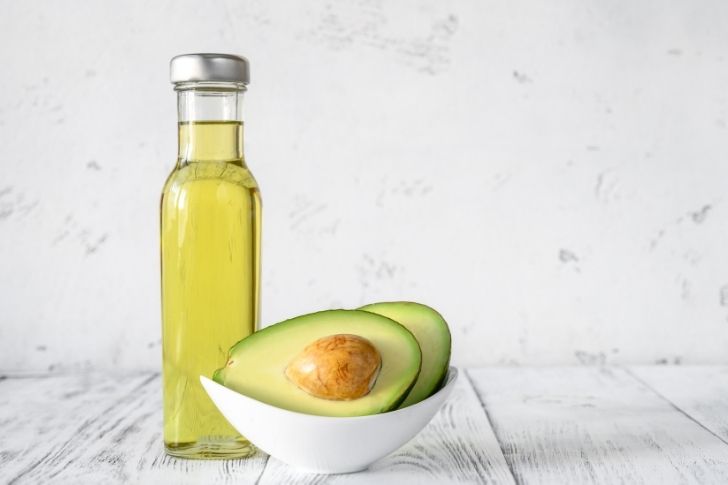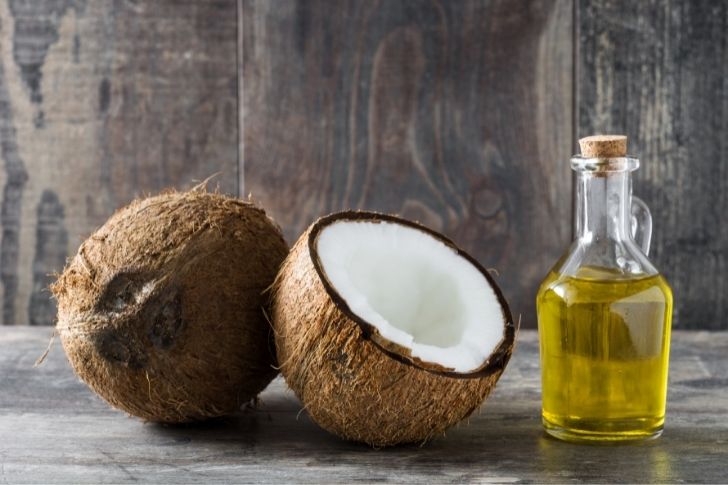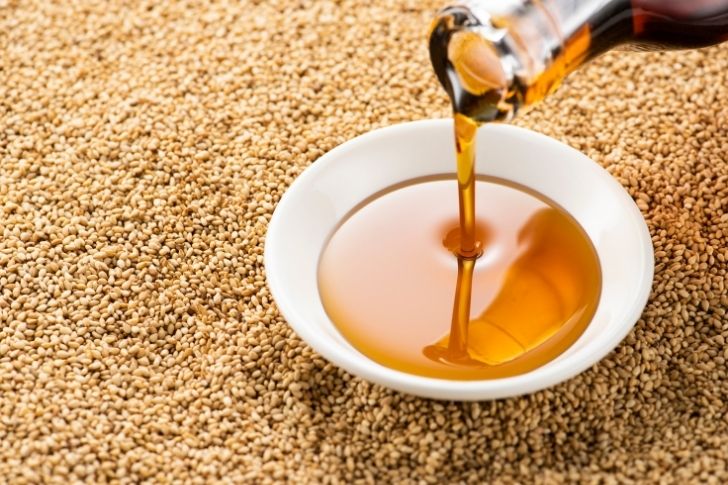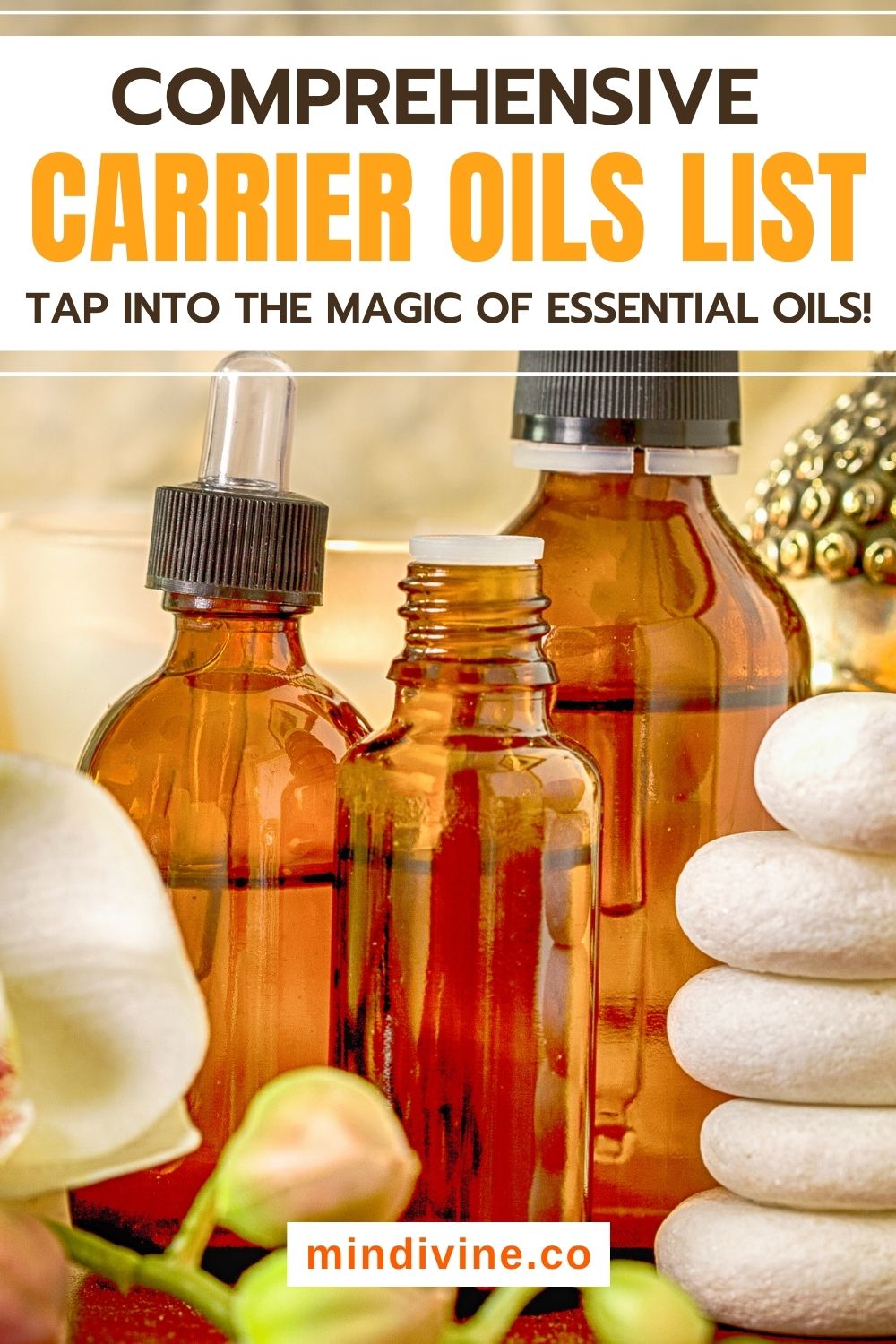You have probably already heard about the many benefits of essential oils. However, these pure oils are powerful and potent, and it is necessary in all cases to dilute them with carrier oils before applying them to the skin.
Therefore, the chances are that if you have already used essential oils, you have also used carrier oils, also known as base oils.
In this way, carrier oils are a perfect complement to the use of essential oils. They can be applied safely and effectively to improve the health and appearance of skin and hair.
There are a large number of carrier oils that can be used. The ideal situation is that you choose the appropriate one according to your skin type and the ailment or problem you want to treat. That is why I have written this post. Here, I will tell you everything you need to know about these types of oils: what they are, which ones there are, what benefits each one has, what skin types to use them on, as well as what precautions you should take. Keep reading if you want to know which carrier oil is best for you to use, and get instructions about using it.
What are Carrier Oils?
Carrier oils, also called base oils, are vegetable oils extracted from plants, usually grains, seeds, or nuts.
Commonly, their function is to dilute essential oils, mainly when the latter is to be used on the skin. Experts do not recommend applying pure carrier oils because they can cause certain adverse side effects.
Base oils are usually unscented or have a mild and light aroma, so mixing them with essential oils does not interfere with or diminish their aromatic properties.
Many of these vegetable oils can also be used alone.
Why Use Carrier Oils?
As already mentioned, carrier oils are normally used to dilute concentrated and pure essential oils. Doing so results in a mixture suitable for topical use, among other uses that can be given to them.
These oils are intended to serve to “transport” the essential oils on the skin and hair so that they do not cause burning, irritation, redness, or sensitization.
There are actually a wide variety of carrier oils that you can use, and each one has different health benefits and therapeutic properties.
So, depending on the benefit you are looking for, your skin type, and the essential oil with which you want to mix it, you should choose one or the other of these carrier oils.
The following is a list of the most popular base or carrier oils that are commonly used in the dilution of essential oils, whether for massage, aromatherapy, or baths.
However, before I give you this list, I will briefly tell you about the comedogenic scale and its importance when choosing one or another oil, depending on your skin type.
Comedogenic Classification
The comedogenic scale is a classification based on the probability that certain ingredients, such as oils or butters used in the manufacture of cosmetic products, can clog pores.
When a person is susceptible to acne outbreaks and pimples or blackheads, they should avoid using highly comedogenic oils because the problem will most likely be aggravated.
And on the other hand, people with drier skin can take advantage of emollient oils that are in the middle of the scale.
The comedogenic scale or classification is a numbering system ranging from 0 to 5, with each of these numbers being considered as follows:
- Comedogenic rating: 0 – Should not clog pores at all.
- Comedogenic rating: 1 – Very low probability of clogging pores.
- Comedogenic rating: 2 – Low to moderate probability of clogging pores.
- Comedogenic rating: 3 – Moderate likelihood of clogging pores.
- Comedogenic rating: 4 – A fairly high probability of clogging pores.
- Comedogenic rating: 5 – Probability of clogging pores high.
Oils considered non-comedogenic are those that have a zero or low probability of clogging pores and typically have a rating of 2 or less.
Any oil with a rating of 5 will almost certainly clog pores, and if the person is prone to acne, may cause breakouts.
However, it should be clarified that there are many factors that influence how a particular oil will impact each person’s skin. So different oils may impact differently on different people with the same skin type.
Factors that can influence this range of results include skin type, water intake, the disease or problem being treated, and environmental factors, among other aspects that will influence how the oil acts on the skin.
It is also important to keep in mind when choosing an oil that the fatty acid composition will be a substantial factor in determining exactly what type of skin will benefit from each particular oil.
List of the Most Used and Recommended Carrier Oils
Avocado Oil
Avocado oil has a comedogenic rating of 3 and is normally suitable for dry, combination, aging, and sensitive skin types.
It helps treat skin problems such as psoriasis and eczema and diminishes the appearance of wrinkles and fine lines.
In 1918, the British Institute first extracted avocado oil, made from the avocado fruit itself. It is a thick oil with a pleasant nutty aroma.

As with most carrier oils, this oil is very beneficial when applied to the skin, improving skin tone and moisturizing it, although it is not recommended for use when acne is present.
It has a high content of vitamins, minerals, and fatty acids, so it is good for improving collagen production, especially in younger skin.
Avocado oil is rich in oleic acid, a monounsaturated acid that is especially beneficial for dry and damaged skin and also helps to reverse the signs of aging.
Many women use it by applying it to the face to eliminate impurities.
It is also good for improving hair health.
Apricot Kernel Oil
With a comedogenic classification of 2, it is an ideal oil for dry skin. Apricot kernel oil is a very good anti-inflammatory, anti-aging, antibacterial, and antiseptic, helping, among other things, to treat acne-prone skin.
It is also rich in vitamins A and C and essential fatty acids.
This oil is also good for oily skin, as it absorbs very well without leaving a greasy feeling.
Since more than 3,500 years ago, in ancient Chinese medicine, this oil has been used to treat mainly nephritis.
It is obtained from the seeds of the apricot tree, which is native to Iran, Azerbaijan, China, Armenia, Turkey, and Syria.
Apricot kernel oil has a mild odor that allows it to be used with essential oils for aromatherapy without attenuating the aroma of the latter.
When mixed with essential oil, such as Lavender, it helps to tone and soften the skin if used topically and is used in preparations to improve hair health.
Sweet Almond Oil
Almond oil has a comedogenic classification of 2, making it a perfect oil for sensitive skin, dry skin, as well as acne-prone skin.
This oil was used in ancient times in Chinese and Ayurvedic medicine to treat skin conditions such as psoriasis and eczema.
Almond oil is rich in antioxidants, which help to keep the skin smooth and soft. As it is a light oil, it is easily absorbed.
It also has emollient properties that improve skin tone and is excellent for regenerating damaged skin cells.
If combined with essential oils, such as Tea Tree or Lavender, which have antimicrobial properties, it is useful for cleansing the skin by penetrating the follicles and pores.
Argan Oil
With a comedogenic classification of 0, argan oil is a suitable oil for most skin types. It is even gentle enough to apply on sensitive skin and on combination, oily, dry, and aging skin.
This oil is obtained from the kernels found inside the fruit of the Argan tree, which is native to Morocco. Moroccans have used it for over 3,500 years to nourish the body both inside and out.
It is very rich in vitamins A and E, antioxidants, minerals, and monounsaturated essential fatty acids such as linoleic acid and omega-6 fatty acids.
Argan oil is ideal for moisturizing, softening, and protecting the skin, as well as reducing the signs of aging and improving its elasticity and tone.
It helps treat various problems such as inflammation, stretch marks, and wrinkles because it promotes cell production.
It can also be used to treat acne, psoriasis, and eczema and helps to fade scars and skin blemishes.
Argan oil contributes to the growth of healthy hair, as its antioxidants help stimulate the cells of the scalp.
Hazelnut Oil
Hazelnut oil has a comedogenic classification of 1, which makes it perfect for use on most skin types, especially sensitive skin prone to acne.
It has been used for centuries for its great antioxidant and astringent properties and for being a very good source of healthy fats, vitamins, and proteins.
These components help nourish the skin and protect it from sun damage while increasing collagen production. Therefore, it is also good for hair care.
Safflower Oil
Its comedogenic classification is 0, making its use very appropriate for all skin types, whether combination, oily, sensitive, dry, or aged.
Safflower oil reduces wrinkles and helps fight and treat psoriasis and eczema, as well as inflammation and acne.
This oil is also useful to improve hair health.
It is extracted from the seeds of the safflower plant, which was a very important plant in ancient cultures such as the Greeks and Egyptians. Thus, its use dates back more than 4,000 years ago.
Coconut Oil
Coconut oil has a comedogenic rating of 4 and is very useful for dry and chapped skin, helping to improve its appearance and health.
It diminishes skin blemishes but is not recommended for use if you have acne-prone skin.
This oil is obtained from the meat of ripe coconuts and is a very good carrier oil.
Like most vegetable oils, it is rich in vitamin E, fatty acids, and polyphenols that help moisturize and nourish the skin. It is very good for massages and preparations, leaving the skin soft and shiny.

Coconut oil protects the skin from the sun’s rays and has great healing and anti-aging properties, as it stimulates collagen production.
It is also antiseptic and antimicrobial, so it is very good for healing wounds and reducing inflammation. It helps to relieve psoriasis, eczema, and cold sores.
Coconut oil has a low molecular weight, which allows it to penetrate the skin very well even at a deep level.
Sea Buckthorn Oil
Its comedogenic rating is 1, making it suitable for most skin types, especially dry skin.
It is an oil that is rich in omega-3, 6, 7, and 9 fatty acids and in vitamins A, C, D, and E.
It has antioxidant and antibacterial properties that help the body protect itself from infections caused by viruses, parasites, and bacteria.
It is also a great anti-inflammatory, helping to reduce redness and regenerate skin cells.
It can also be used to treat skin conditions such as acne, stretch marks, dermatitis, and eczema.
Sea Buckthorn Oil protects against sun damage and is used to soothe sunburn. It also improves the structure of the skin, keeping it healthy and accelerating the healing of wounds.
Jojoba Oil
Jojoba oil has a comedogenic classification of 2 and is a suitable oil for oily skin because it helps balance excess sebum production. It can also be used on sensitive, aging, and dry skin.
It helps to combat rosacea, psoriasis, and eczema and to reduce wrinkles. Its use can improve acne problems and leave skin pores clean and free of impurities.
Jojoba oil is also good for treating sunburns and wounds thanks to its anti-inflammatory and antifungal properties.
This oil is obtained from the seeds of the jojoba plant and is an excellent carrier oil. It can be used alone because it is very rich in vitamins A, B, and E and fatty acids.
It is very easily absorbed by the skin and detoxifies and revitalizes it.
It is an excellent option for topical application in facial and body massages.
Linseed Oil
It has a comedogenic rating of 4, so most skin types do not usually tolerate this oil well, especially acne-prone skin.
This oil has been used since ancient times, mainly in Ayurvedic medicine. In Ayurvedic medicine, it is used to improve wound healing and balance the pH of the skin, as well as to eliminate blemishes.
Also known as flaxseed oil, it also helps with skin problems such as eczema and psoriasis. It is very good for improving skin elasticity, texture, and tone.
It is a soothing oil and is therefore very popular as a carrier oil, both for topical use and for application in aromatherapy.
In addition, it should be noted that because it contains omega-3 fatty acids and alpha-linolenic acids, it helps to reduce skin inflammation and improve hair health.
For all these reasons, it is an excellent carrier oil with which you can achieve very good results on both skin and hair.
Neem Oil
Neem oil has a comedogenic classification between 1 and 2 and is used for dry, combination, and oily skin.
It helps to treat eczema and psoriasis and is useful in reducing acne scars and inflammations. In addition, because it is a great antibacterial, it is effective in treating acne-prone skin.
This oil has a strong odor, similar to that of boiled peanuts.
Neem oil is high in fatty acids, antioxidants, and vitamin E and is rapidly absorbed by the skin. It soothes and improves the appearance of damaged and dry skin without creating a greasy appearance.
It also helps to reduce irritation while moisturizing and protecting the skin. As a result, it improves elasticity and rejuvenates cells while protecting them from environmental damage.
It is used as an ingredient in a large number of products, both natural and industrial, for beauty and cosmetics.
Olive Oil
Olive oil has a comedogenic classification of 2. It is perfect for rather dry and acne-prone skin, although it can also be used on combination and aging skin.
This oil originates from the Mediterranean and has been used for centuries both in cooking and in medicine; in the latter case, especially in skincare.
It is extracted from pressed olives, resulting in a very pleasant, fruity-smelling oil. It is highly healthy, whether it is consumed or used topically or through aromatherapy as a carrier oil.
This oil contains healthy fatty acids, phenols, and sterols, as well as being anti-inflammatory and antioxidant.
It is widely used to nourish, moisturize, and cleanse the skin, especially dry and mature skin. It also helps to reduce inflammation and pain as well as bacterial growth.
Olive oil also reduces the signs of aging and accelerates wound healing while preventing and fighting infections.
Research supports the belief that it is useful in combating skin diseases such as psoriasis, atopic dermatitis, seborrheic dermatitis, and acne.
Olive oil is used to make homemade soaps and as an ingredient in various cosmetic products such as facial cleansers and creams.
The variety most commonly used for these purposes is extra virgin olive oil, mainly when used as a carrier oil for essential oils for aromatherapy preparations.
Evening Primrose Oil
It has a comedogenic rating of 2 to 3 and is excellent for oily, acne-prone skin but is not normally useful for dry skin.
As with most vegetable oils, this oil is very rich in essential fatty acids and is a great anti-inflammatory.
Thanks to these properties, it can be used topically to soothe irritations, improve skin elasticity, reduce inflammation, and improve its cellular structure. It is also very useful in treating skin problems such as acne or atopic dermatitis.
In addition, evening primrose oil improves nerve function and reduces hyperpigmentation.
Combining it with antimicrobial essential oils, such as tea tree oil, helps treat various skin conditions and improve your overall health.
It is also believed to be useful in stimulating hair growth.
Castor Oil
Castor oil has a comedogenic rating of 1, making it suitable for various skin types such as dry, combination, oily, and aging skin.
It helps fight and improve the appearance of acne, stretch marks, scars, skin blemishes, and wrinkles and is also good for treating sunburn and infections.

Castor oil is used to treat skin conditions such as dermatitis and psoriasis.
This oil has been used for thousands of years by various cultures, mainly for medicinal purposes. It is extracted from the seeds of the Ricinus communis plant.
Castor oil is widely used as an ingredient in beauty and skincare products.
Rose Hip Oil
Rosehip oil has a comedogenic classification of 1 and is particularly suitable for oily skin prone to acne. However, it can be used on combination, dry and aging skin.
It helps improve the appearance of skin with hyperpigmentation, stretch marks, and rosacea and diminishes fine lines and blemishes caused by burns and scars.
Rose hip oil is rich in vitamins A and C and has a high content of antioxidants that improve, revitalize, and tone the skin.
In addition to helping to combat aging and reverse the effects of the sun, it is especially good for dry, damaged, and irritated skin.
Rosehip oil is rapidly absorbed by the skin and leaves no oily residue.
Broccoli Seed Oil
Broccoli Seed Oil has a comedogenic classification of 1, being very good for very sensitive and dehydrated skin.
This vegetable oil is extracted from the seeds of broccoli sprouts and contains a large number of antioxidants, as well as omega-3, 6, and 9 fatty acids.
It is colorless and odorless, a very light and effective vegetable oil.
It is an excellent moisturizer and absorbs very easily, leaving no greasy residue.
Broccoli Seed Oil improves the appearance of the skin, making it look healthier, brighter, and smoother. At the same time, it moisturizes and rejuvenates, helping to eliminate wrinkles.
It is also good for improving hair health, reducing dryness, and promoting shiny, healthy hair.
Hemp Seed Oil
This carrier oil has a comedogenic classification of 0, making it ideal for combination and dry skin as well as for aging and sensitive skin.
Hemp Seed oil helps treat eczema and psoriasis and reduces wrinkles.
It is rich in vitamins E and C, in addition to containing fatty acids and amino acids similar to natural skin oils.
This oil is a very good emollient, cleansing the pores and helping to moisturize the skin. It improves the skin’s appearance, as well as combats and prevents acne.
It has a mild nutty aroma.
Ideally, when buying this oil, it should be organic, unrefined, and obtained by cold pressing.
Sunflower Seed Oil
This oil has a comedogenic classification between 0 and 2. Most skins respond very well to this oil, whether they are oily, sensitive, combination, dry, or aging.
It is extracted from sunflower seeds, has a neutral aroma, and, according to experts, was first cultivated by Native Americans more than 3,000 years ago.
Sunflower Seed Oil has excellent antioxidant properties, in addition to vitamins, essential fatty acids, and minerals.
It fights the signs of aging, and moisturizes, softens, and regenerates the skin. It is also very good for treating eczema and psoriasis, as well as wrinkles.
The oil acts as a skin barrier against germs and toxins that cause infections. It is, therefore, a great choice for application on irritated and acne-prone skin.
Since it is suitable for most skin types, it can usually be used safely.
Black Seed Oil
It has a comedogenic classification between 0 and 1 which makes it especially useful for dry, devitalized, and damaged skin, as well as sensitive skin.
This oil is obtained from the seeds of the Nigella sativa plant, native to Southwest Asia.
Although it is not as well known as other carrier oils, such as Jojoba or Coconut oil, it is very rich in antioxidants and saturated and unsaturated fatty acids.
In Asia, Black Seed oil is a popular remedy widely used to relieve skin problems such as acne, psoriasis, and eczema.
It also helps to improve the appearance and health of the hair.
Black Seed Oil is a good anti-inflammatory.
It is highly recommended for use as a carrier oil to be applied topically in massages and for facial care.
Grapefruit Seed Oil
This oil has a comedogenic rating of 2 and is very good for oily skin prone to acne.
It has excellent antifungal, antioxidant, anti-inflammatory, and antiseptic properties, helping to reduce and eliminate bacterial and fungal infections.
Grapefruit Seed oil is used as an ingredient in many cosmetic and beauty products, such as toothpaste, disinfectants, mouthwashes, and shower gels.
It can be used as a carrier oil for aromatherapy with humidifiers, or topically.
Grape Seed Oil
Its comedogenic classification is between 1 and 2. It is perfect for acne-prone skin and can also be used on combination, aging, sensitive, and oily skin.
This oil comes from grape seeds and is a by-product of the winemaking process.
It is a light oil but has great properties, is easily absorbed, and has a neutral scent.
Grape Seed Oil is very rich in vitamin E and is a great anti-inflammatory, especially good for skin care.
The oil helps to diminish wrinkles, improving the appearance of wrinkles. It prevents and treats acne, reducing the redness caused by acne.
As a carrier oil, it is very good when used for massages and body baths.
Combined with essential oils, it can be applied topically on the skin to tone it and protect it from sun damage and the appearance of spots and stretch marks.
Sesame Oil
Sesame oil has a comedogenic rating of 3, so it is good for dry, combination, and aging skin.
This oil is rich in vitamin E and essential fatty acids.
Sesame oil is extracted from sesame seeds.
It has great antioxidant properties that make it good for combating skin aging and improving expression lines. It also prevents the appearance of wrinkles.

It also detoxifies the skin, helping to prevent and fight acne, thanks to its anti-fungal and antibacterial properties.
Ideally, when using this oil, it should be extracted using the cold-pressing technique, and be organic and unrefined.
How to Choose the Right Carrier Oil for You. Buying Tips
There are many of these oils on the market, which are available both in physical and online stores.
But before you buy them, you must take into account certain aspects:
- Odor: Carrier oils usually have a very mild aroma, or no aroma at all. However, some can have a stronger odor and this can alter the aroma of the essential oil with which they are mixed. This is important to keep in mind, especially if you want to use it for aromatherapy.
- Absorption: Certain carrier oils are better absorbed by the skin than others. It will depend on the characteristics of your skin and which one to choose.
- Skin type: Depending on your skin type, some of these oils may irritate or cause allergies, or worsen conditions such as acne. Therefore, if you have any doubts, you should consult a specialist about which one to use.
- Shelf life: Not all vehicle oils have the same shelf life. There are some that can be stored for longer periods of time without deteriorating or losing their properties. In this sense, it is very important to store them taking the necessary precautions and following the recommendations.
Always choose carrier oils that have been produced by a reputable manufacturer.
Make sure they are organic oils extracted by the cold-pressing method, 100% pure, and free of preservatives and additives. Heat extraction methods can damage their qualities and properties.

Base Oils: Precautions
Normally most carrier oils are suitable for even the most sensitive areas of the skin and do not usually cause allergic reactions.
However, it is always advisable to do a tolerance test on a small area of skin. You can apply it on the wrist or the inside of the forearm before applying it on a larger area to make sure there are no adverse reactions.
Keep in mind that, as with essential oils, some people may develop allergic reactions to certain types of carrier oils. Thus, in case of irritation or other adverse reactions, you should discontinue use and consult your physician.
How to Store Carrier Oils
Always be sure to store your carrier oils in a dark-colored glass bottle and place it in a dark, cool place. You can even store it in the refrigerator.
Some oils can become rancid over time, which will cause them to have a bitter and strong odor. If you notice this, you should discard that oil and buy a new one.
Conclusion
In relation to the use of essential oils and carrier oils, there is no single recipe to follow. Each person must find the best and most suitable for his or her particular case.
Ideally, experiment with different oils and find the perfect blend for you. Pay attention to how your body responds to each oil.
In general, the carrier oils described in this post are suitable for use in most cases.
These vegetable oils can be found in pharmacies and natural product stores, both online and physically. On Amazon, you have a wide variety of oils to choose from, of excellent quality and reputable brands.
Regardless of which base oil you choose, always avoid use on sensitive areas.
I really hope you have found this post with the complete list of carrier oils for your essential oils very useful.
If you liked this post, please share it. Save THIS PIN below to your Essential Oils board on Pinterest and check it later! 🙂


